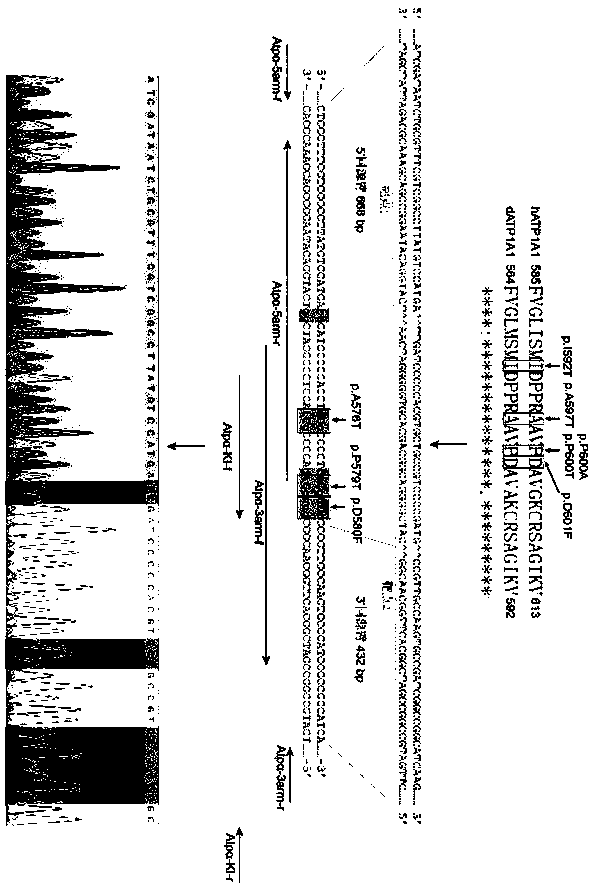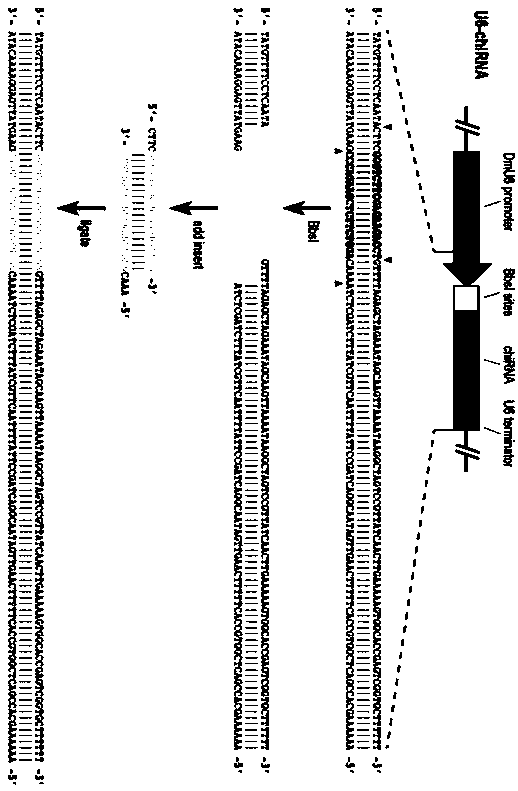Construction method and application of axonal Charcot-Marie-Tooth drosophila model
A Charcot-Marie-Tooth disease and construction method technology, applied in the field of Drosophila model construction, to achieve the effects of simple drug feeding, rapid drug screening, and fast drug screening
- Summary
- Abstract
- Description
- Claims
- Application Information
AI Technical Summary
Problems solved by technology
Method used
Image
Examples
Embodiment 1
[0025] Gene editing and result identification of Drosophila ATPα mimicking human ATP1A1 amino acid mutations
[0026] Selection of Atpα mutation sites, such as figure 1 As shown, we simultaneously selected three mutations corresponding to human ATP1A1 for simulation, including p.A597T, p.P600T, and p.D601F, and the sites corresponding to the Drosophila Atpα gene were p.A576T, p.P579T, and p. D580F.
[0027] According to the genome sequence information where the site to be mutated is located, such as figure 1 As shown, a pair of CRISPR / Cas9 genome editing targets were designed, target 1: 5’-GCACGTGGGGGATCAATCA-3’ and target 2: 5’-GTCGGCACTTGGCAACGGCAT-3’. Such as figure 2 As shown, the two target sequences were respectively constructed on the pU6-BbsI-gRNA (Addgene: 45946) vector. Synthesize two target primers (forward: 5'-CTTC (target sequence)-3' and reverse: 3'-(target sequence)CAAA-5') according to the template for each target, and the The 5'-CTTC-3' and 3'-CAAA-5' ...
Embodiment 2
[0034] Pathological evaluation of the CMT2 model of Drosophila ATPα mimicking human ATP1A1 amino acid mutations
[0035] The established Drosophila model was subjected to immunostaining of the brain clock nervous system circuit and observation of circadian clock-related behaviors to evaluate pathological phenotypes. Immunostaining protocol: 3-5 day old Drosophila adults were collected and fixed in 4% paraformaldehyde fixative for 2 hours at room temperature. Dissect with pointed tweezers for dissection, remove the treated Drosophila brain from the worm body, put it into 150 μL PBST (PBS+0.5%Teiton X-100) for room temperature washing, 3 consecutive times, 15min each time . Then transfer to 150 μL PNT (PBST+10% goat serum for blocking) and incubate at room temperature for 2h for blocking. Afterwards, PNT was used to dilute the primary antibody (mouse anti-PDF 1:200, DSHB), and the blocked brain was transferred to the primary antibody at 4°C overnight. Wash 3 times with PBST a...
Embodiment 3
[0038] Example 3 Drosophila ATPα simulates the application of CMT2 model of human ATP1A1 amino acid mutation
[0039] Using the established Drosophila model, we evaluated the neurological drug oxcarbazepine. Specific scheme: firstly, the food containing the drug is prepared, and the neurological drug oxcarbazepine (O3764) from Sigma Company is dissolved in a solution containing 1‰ dimethyl sulfoxide to prepare a 120 mM stock solution, and then the final concentration is 120 mM The amount of μM is mixed with 0.75% soybean flour (g / ml), 4.5% corn flour (g / ml), 1.5% yeast (g / ml), 0.5% propionic acid (v / v), 0.1% paraben Methyl ester (g / ml), 0.02% corn syrup (v / v), 1.25% sucrose (g / ml), 1.25% glucose (g / ml), 0.5% agar (g / ml) food. The control food was prepared with normal food mixed with dimethyl sulfoxide at the corresponding concentration of drug food. Next, the control and pathological Drosophila models 2-3 days after eclosion were collected and put into the food containing th...
PUM
 Login to View More
Login to View More Abstract
Description
Claims
Application Information
 Login to View More
Login to View More - R&D
- Intellectual Property
- Life Sciences
- Materials
- Tech Scout
- Unparalleled Data Quality
- Higher Quality Content
- 60% Fewer Hallucinations
Browse by: Latest US Patents, China's latest patents, Technical Efficacy Thesaurus, Application Domain, Technology Topic, Popular Technical Reports.
© 2025 PatSnap. All rights reserved.Legal|Privacy policy|Modern Slavery Act Transparency Statement|Sitemap|About US| Contact US: help@patsnap.com



